6-2 Early Social and Emotional Development: Emotions and Identity
A – Emotions and Identity
The remaining two of the four social and emotional subdomains describe children’s development of emotions and their own identity:
- Emotional Functioning
- Sense of Identity and Belonging
The subdomain Emotional Functioning describes the development of children’s ability to both express and interpret emotions. These are key skills for social development, including relationship building.
The subdomain Sense of Identity and Belonging describes the development of children’s self-awareness—who they are and what they can do.
Emotional Functioning
Scientists define emotion as readiness to establish, maintain, or change your relation to the environment on a matter of importance to you. This definition is based on what is considered to be the function of emotion, which is to motivate behavior to attain personal goals.
Researchers have identified six universal emotions that older children and adults express:
- Happiness
- Sadness
- Anger
- Fear
- Surprise
- Disgust
These emotions are expressed using many different social signals, such as facial expressions, tone of voice, and body posture and gestures. The facial expressions associated with these emotions are universally recognized across cultures.
Children begin to learn about emotions at birth through back-and-forth interactions with their caregivers. A caregiver smiles and his baby smiles back. A child pouts with her bottom lip to let her mother know she is upset, and the mother acts accordingly.
Young infants are limited in their ability to control their environment. One way they are able to regulate their emotions is by approaching or avoiding situations. Before a child can move, they can turn their head away from scary or unpleasant situations or close their eyes—these are both demonstrations of avoidance.
Once they can crawl or walk, they can begin to physically remove themselves or back away from unpleasant situations or even physically draw nearer to or point toward pleasant ones.
As children engage in more and more complex back-and-forth interactions and are able to engage the environment on their own terms, their emotional understanding grows.
Emotional Expression
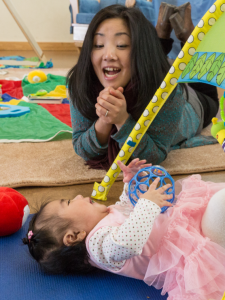
Initially, infants are quite limited in their emotional expressions.
Between 6 and 10 weeks of age, infants begin to demonstrate what is called a social smile—a smile in response to a caregiver’s expressions or actions. Prior to this time, infants sometimes smile, but it is widely recognized that these out-of-context smiles are the product of reflexes. Interestingly, the development of the social smile parallels that of face processing, a perceptual skill.
Face processing develops within the first 2 months of life and continues to improve throughout the first year of life. During these first 2 months is when that the social smile also begins to occur. And some researchers believe that infants’ increasing ability to distinguish internal caregivers’ facial characteristics, such as the configuration of their mouth and eyes, helps them develop a social response (social smile) to their caregivers’ expressions.
Laughter develops at about 3 to 4 months.
This is then followed by a rise in fears around 6 months. This rise in fears is actually helpful, since it keeps exploring babies safe. Infants’ fearfulness during uncomfortable or ambiguous situations motivates them to use adults as their secure base.
As children develop their motor abilities, they naturally will try to take more control of their environment. As they gain control, they may need to defend themselves or overcome obstacles more often.
The expression of anger during this time increases, and researchers consider this an adaptive response. Anger at this age can help children to defend themselves or overcome obstacles.
Recognition of Emotions
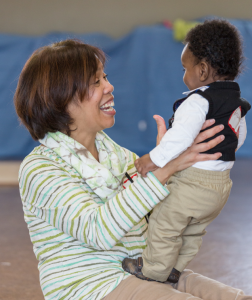
Recognition of emotions develops at the same time as the expression of emotions.
While very young infants will often cry in response to another infant’s cries, they are not necessarily understanding the cry as an expression of emotion. Rather, they find the crying unpleasant and react to it by crying themselves, just as they would react to any unpleasant situation.
Scientists have found evidence that between 5 and 7 months infants show some recognition of adult emotional expressions. In one study, 7-month-old infants simultaneously saw two videos of an adult making an emotional expression. In each video the adult made a different emotional expression. While they watched the two videos, infants also heard a single verbal emotional expression that matched only one of the two videos. Infants in this study were able to tell the difference between happy, interested, sad, and angry emotional expressions.
The ability to recognize others’ emotions and understand them is a key step in the developmental of empathy and sympathy.
B – Cultural Effects
Emotional expression and recognition within a specific culture is governed by a set of emotional display rules that are greatly affected by socio-cultural differences.
During their second year of life, children can use emotions that are not directly communicated to them to learn about rules in their family, society and culture. Children are learning all the time simply by observing and listening to the people around them.
One thing children learn by watching and noticing the responses of adults is the set of rules about where and when it is appropriate to express emotions. These rules are called: emotional display rules.
Those rules, and thus the expressions of emotion, can differ considerably between different cultures and social groups. For example, researchers found that even within the same country, children’s early emotion socialization experiences differed greatly.
Scientists observed the interactions between 119 Nepali children and adults. They found that depending on which socio-cultural group the children belonged to, they learned very different sets of emotional display rules.
To encourage children in the indigenous population of Tamang people in Nepal to be socially graceful, adults showed disapproval of children’s expressions of anger and reasoned with the children who expressed shame.
In contrast, children in the Brahmin caste of Nepalese people were ignored if they expressed shame and were reasoned with if they expressed anger.
These differences reflect the different goals of each socio-cultural group.
Emotional Regulation
Between birth and 3 years of age, children begin to develop skills and strategies to regulate their own emotions with the guidance of caregivers, such as using language or distraction strategies.
Emotional self-regulation in early childhood consists primarily of the development of strategies to adjust one’s emotional state to a comfortable level.
Emotional self-regulation develops with guidance of caregivers.
Between 1 and 1½ years of age children begin to show the emergence of self-regulation with the growing awareness of caregiver wishes and expectations.
By age 2, children are beginning to use language to identify and control their feelings.
It is also around this time that children begin to be able to delay their own gratification, a major step toward self-control and self-regulation. Between 1½ and 3 years of age, this skill increases through the learning of strategies, such as distraction techniques: paying attention to something else to distract yourself from the desirable object while you wait.
However, emotional regulation continues to develop throughout childhood (and even into adulthood).
At the end of this lesson, we will discuss some methods for helping young children build emotion regulation skills.
Vroom Tip
Check out this Vroom tip to get more ideas about how to support social and emotional development in young children.
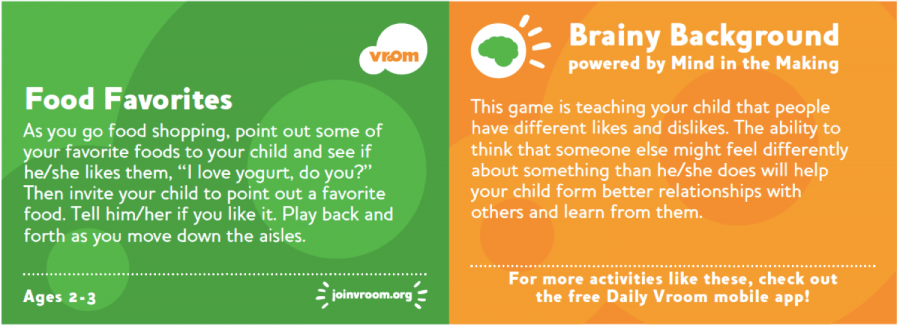
View text-only alternative of this Vroom card
Food Favorites
As you go food shopping, point out some favorite foods to your child to see if he/she likes them, “I love yogurt, do you?” Then invite your child to point out a favorite food. Tell him/her if you like it. Play back and forth as you move down the aisles.
Ages 2-3
Brainy Background powered by Mind in the Making
This game is teaching your child that people have different likes and dislikes. The ability to think what someone else might feel differently about something he/she does will help your child form better relationships with others and learn from them.
Read the Vroom tip. Does this tip make sense in the context of an early learning environment? And if not, how might you adapt the activity to better fit that environment?
C – Sense of Identity and Belonging
Children discover who they are through the development of self-awareness, self-identity, and self-confidence.
The Head Start Early Learning Outcomes Framework subdomain of Sense of Identity and Belonging includes the development of at least three developmental skills:
- Self-awareness: the awareness of the self as separate and different from others.
- Self-identity: the development of knowledge of a set of attributes and abilities that define who one is.
- Self-confidence: the positive evaluation of one’s own abilities.
In the first year of life, infants and caregivers are discovering together who the infant is. It is important to let infants express themselves and to create a responsive environment.
Self-Awareness
Even very young infants have an implicit sense of self-awareness. Infants react less to their own touch than to the touch of others or to their own image than to an image of another person.
However, infants have not yet developed an explicit sense of self. When presented with a mirror showing a dot on their face, they reach for the dot on the mirror rather than on their own face.
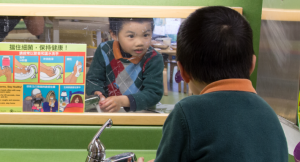
In contrast, in the middle of the second year, toddlers begin to develop awareness of the self as separate and different from others. Around 20 months, toddlers begin to show signs of self-recognition: identification of the self as a physically unique being.
Toddlers observing a dot on their face in a mirror will touch the dot on their own face rather than the mirror itself. They also begin to use personal pronouns, such as I, me, and us.
It is also during this time that self-conscious emotions begin to develop such as guilt and pride.
Body Self-Awareness
Scientists asked 16- and 21-month-olds to push a toy cart to their mothers to study children’s self-awareness of their own body.
What the children didn’t know beforehand was that when they went to push the cart, it was rigged so that they would step on a mat connected to the cart. Their own body weight would prevent the cart from moving. To complete the task, they would have to move their body off the mat first to be able to move the cart forward.
Children who were 21 months old performed significantly better than 16-month-olds on this task, but that could just be because they had more walking and moving experience. So scientists compared this performance to children’s performance on a second task that did not involve moving one’s own body.
In this second task, another group of 16- and 21-month-olds was asked to push the same cart to their mothers, but this time a paint can was placed on the mat that prevented the cart from moving. In this case, scientists found no difference in performance between the two age groups.
The fact that there was a difference in performance when children had to move their own bodies out of the way, but there was no difference in performance when children had to move an object out of the way, suggests that 21-month-olds’ bodily sense of self-awareness is more developed than that of 16-month-olds in a way that makes it easier for them to navigate their environment.
Video: The Baby Human – Shopping Cart Study (2:45)
We’ll watch the video The Baby Human – Shopping Cart Study, which shows children participating in the shopping cart study.
Watch The Baby Human – Shopping Cart Study from D. Martin on YouTube.
Scale Errors
Another way that toddlers demonstrate their developing sense of self is in scale errors. A scale error is when a child tries to fit into objects they don’t physically fit into or tries to do things that their body size makes impossible.
In another body awareness study, this time investigating children’s scale error, researchers first presented children with appropriately sized toys—a large toy car they could get in and out of, a slide to slide down, and a chair to sit in.
Next, the children went to a new room that only contained miniature objects. Some of these objects were exact miniature replicas of the large objects the children had just played with.
Children around 20 months of age tried to play with the miniature objects the same way they had played with the large objects, trying to squeeze their foot in the small car after opening its tiny door, trying to slide down the slide by sitting on the whole object, or trying to sit in the tiny chair.
By about 2 years of age, children no longer committed these scale errors. Instead, when presented with the miniature toys, they played with them as they would other toys, pushing the miniature car around on the floor or using their hand to slide down the slide.
Thus, it appears that around 20 months of age, children develop a new sense of awareness about their own body and how their body can interact with the world.
Video: The Baby Human – Scale Error (2:34)
Now, we’ll watch a video called The Baby Human – Scale Error, which shows children participating in a study investigating scale error. Around 20 months of age, children develop a new sense of awareness about their own body that allows them to make better decisions about which actions are possible and which are not.
Watch The Baby Human – Scale Error from D. Martin on YouTube.
D – Self-Possession
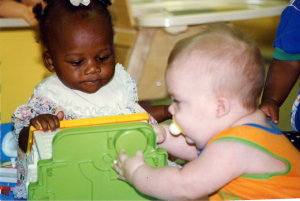
Another form of self-awareness is the development of self-possessiveness by claiming something is: “Mine!”
While most parents and many educators likely will find this new development of self-awareness frustrating at times, it may help to know that it’s not only a sign of developing self-awareness but also a sign of self-assertion that, if confirmed, can help children build a stronger sense of self.
Being able to assert their own space and boundaries is a way for children to explore what their boundaries are and how they can communicate them clearly to others.
This is also where that adaptive expression of anger comes into play for many children. Once a boundary is established, it must also be defended, and expressions of anger are a way for children who don’t yet have a large emotional vocabulary to defend those boundaries.
As adults, we can encourage what children are trying to do while also guiding them toward more positive social behaviors. This is how adults teach children socio-cultural emotional display rules.
It is therefore important to be aware of children’s cultural backgrounds and to discuss behaviors with parents and families to get a better sense of the children’s environments.
To encourage positive relations between peers when one child claims something as their own, an adult can confirm the assertion by saying, “Yes, that is yours,” and then encourage positive behavior by saying, “But in 5 minutes, would you give someone else a turn?”
Self-Confidence
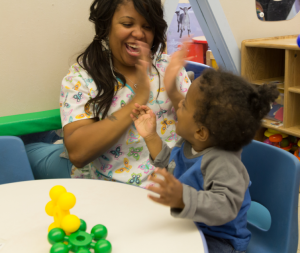
The development of self-confidence begins in infancy with the formation of trusting and loving relationships with caregivers, and it builds with increasing situations where children feel a sense of accomplishment.
Infants that trust that they have secure connections with their caregivers are more likely to feel free to explore the world. They trust that if something goes wrong or they need help, those caregivers will be there for them.
Beyond building trust, providing children with positive feedback helps them build a sense of accomplishment that supports their developing self-confidence. When children think “I can do it,” their self-esteem and self-confidence grows.
Another way to help children build a sense of accomplishment is to let them accomplish things. This may sound obvious, but this can be hard for some adults. A sense of accomplishment is not based on solving a problem but on children believing that they can solve problems on their own.
Caregivers and educators can provide support while children solve problems but avoiding handling them for children. For example, if an infant is struggling to place a block in a shape sorter maybe suggest that they move it around or that they look at the openings some more rather than pointing to the correct opening or placing the block in for them.
Between 18 and 30 months, toddlers begin to develop a categorical self-classification, such as baby or strong, based on perceptual attributes or behaviors. By age 3, self-conscious emotions develop and are linked to self-evaluation.
Vroom Tip
Check out this Vroom tip to get more ideas about how to help children build their self-confidence.
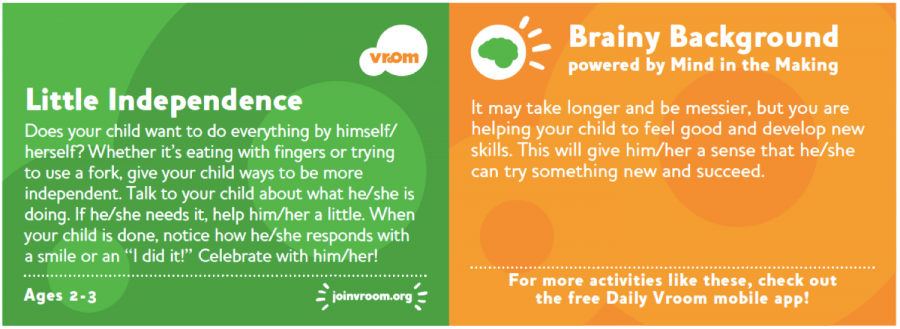
View text-only alternative of this Vroom card
Little Independence
Does your child want to do everything himself/herself? Whether it’s eating with fingers or trying to use a fork, give your child ways to be more to be independent. Talk to your child about what he/she is doing. If he/she needs it, help him/her a little. When you child is done, notice how he/she responds with a smile or an “I did it!” Celebrate with him/her!
Ages 2-3
Brainy Background powered by Mind in the Making
It may take longer and be messier, but you are helping your child to feel good and develop new skills. This will give him/her a sense that he/she can try something new and succeed.
Read the Vroom tip. Does this tip make sense in the context of an early learning environment? And if not, how might you adapt the activity to better fit that environment?
 References
References
Berk, L. (2013). Child development (9th ed.). Pearson.
Campos, J., Frankel, C., & Camras, L. (2004). On the nature of emotion regulation. Child Development, 75(2), 377-394.
Cole, P. M., Tamang, B. L., & Shrestha, S. (2006). Cultural variations in the socialization of young children’s anger and shame. Child Development, 77(5), 1237-51.
Deloache, J. S., Uttal, D. H., & Rosengren, K. S. (2004). Scale errors offer evidence for a perception-action dissociation early in life. Science, 304(5673), 1027-1029.
Grossmann, T. (2010). The development of emotion perception in face and voice during infancy. Restorative Neurology and Neuroscience, 28(2), 219-36.
Martin, D. (2009, May 27). The baby human – scale error. [Video]
Martin, D. (2009, May 27). The baby human – shopping cart study. [Video]
Moore, C., Mealiea, J., Garon, N., & Povinelli, D. (2007). The development of body self‐awareness. Infancy, 11(2), 157-174.
Soken, N. H., & Pick, A. D. (1999). Infants’ perception of dynamic affective expressions: Do infants distinguish specific expressions? Child Development, 70(6), 1275-82.
TUBS. (2011, May 4). World location map (W3). [Online image]
Vroom. (2017). Tools and activities. [Website]
EarlyEdU Alliance (Publisher). (2018). 6-2 Early social and emotional development: emotions and identity. In Child Development: Brain Building Course Book. University of Washington. [UW Pressbooks]

